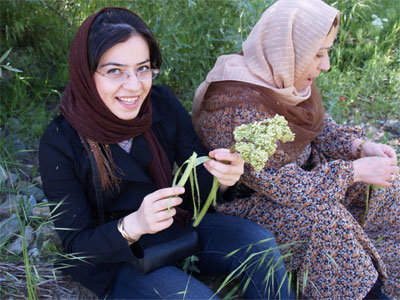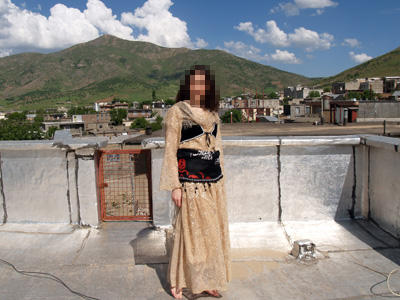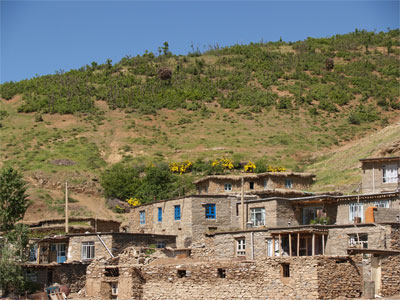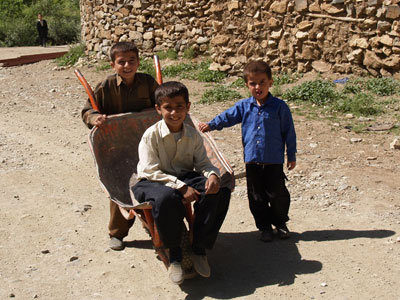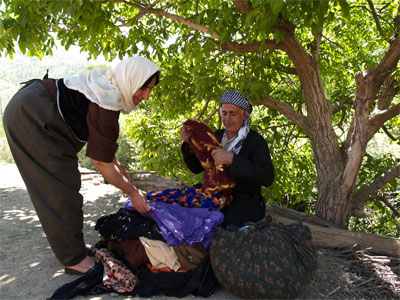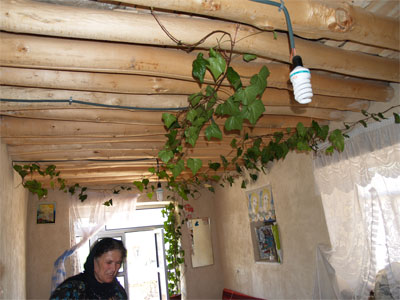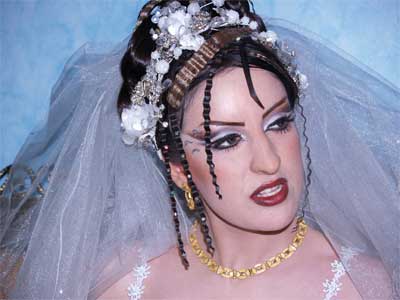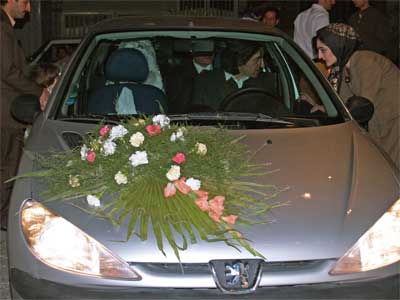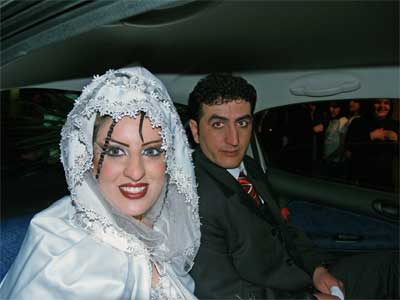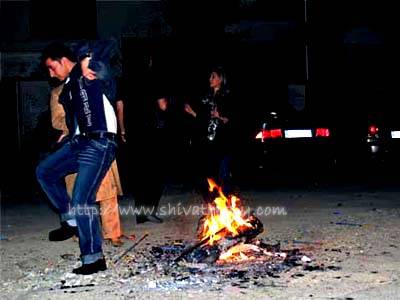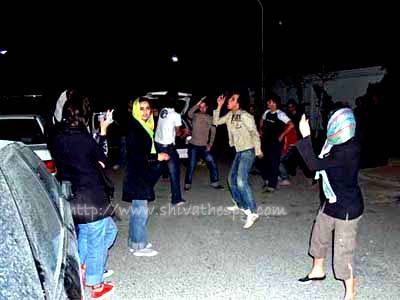It's a lengthy journey from the town of Bonneh, located in the Kordistan province, to the bustling streets of metropolitan Tehran. A 12-hour drive, to be exact. So, my Iranian-Kurdish friend and I booked our return on the "red-eye" bus, so that we could sleep the whole trip, and wake up fully charged the next morning. These cross-country buses are a comfortable alternative to full flights because they've got the snacks, movies, air conditioner, leg room, reclining seats, and other stuff that make 12-hour road trips bearable.
A young attendant, maybe 18 or 19, handed each passenger a pack of cookies, and a cup of orange soda. Now, at 7 p.m., nobody's eaten dinner, because we're all expecting to make a quick stop at the restaurant located en route, around 11 p.m. To ensure I don’t die of starvation, I scarf down both my friend's and my packs of cookies, before we leave the terminal.
Finally, our behemoth of a bus rolls out of the terminal. It's still light outside, as we drive past layers of mountains blanketed in lush greenery. I'm clutching my USC hooded sweatshirt and a pair of thick winter socks that I plan to use if the bus becomes too cold, like it did on the ride to Bonneh.
The evening movie begins. I'm thrilled; we're about to watch an Iranian comedy that I hadn't seen, yet, but had been highly rated. Then, like a sudden slap in the face, the attendant hurries up to the front of the bus, and changes the movie to the most god-awful Iranian production I've ever seen. It was this action film, circa 1980s, about dangerous smuggler gangs, who turn on each other. It was lame, yet would later prove ironic.
My friend explains how the buses that travel from Bonneh to Tehran were notorious for their smuggling of goods.
"It had gotten so bad, that the bus driver wouldn't even make any rest stops. Women with their children, elderly people—it didn't matter; nobody could eat, go to the restroom, or do anything else for 12 hours. The bus would only stop for transferring its contraband.
"Finally, enough people complained, so the police took control of the situation, and the smuggling stopped."
Apparently, since consumer goods cost less in Bonneh, some greedy Tehrani men partnered up with their equally avaricious Bonneh counterparts, and devised a scheme to smuggle products from Bonneh to Tehran, all via these buses. Cheaply priced goods from neighboring Iraq trafficked across the border, and through the nearby town of Bonneh, also enter the illicit trade.
In fact, my friend's little brother, who currently carries out his required two-year military service, says the black bus trade is so lucrative that some soldiers try to get their military service extended, so that they can continue to receive bribes at vehicle check points. He cites an incident where television sets were being trafficked from Iraq to Bonneh, and finally to Tehran. If anybody--i.e., soldiers, toll collectors, and other people who monitor vehicles--were to give any trouble for the hundred televisions being transported, the traffickers would pay them off with a whole set. One television set for each individual that casts a suspicious glance at the contraband! Obviously, the profits must be immense for that kind of gifting.
Fortunately, that's all over, now. The police have caught on to these black-market bandits, allowing us to rest assured that our bus ride home will be squeaky clean.
Wrong. Less than an hour into the trip, the bus slows to a stop in the middle of nowhere—no more fertile hills and valleys; the night has closed in; we're surrounded by vast, desolate plains. Our attendant and the second-shift driver hop out of the bus, and hustle around to the right side to open the compartment. From my window, I observe three Kurdish men, standing next to three massive, flat wooden carts--the kind that have huge wheels and are used to haul around cargo—hoisting huge bundles into the compartment, which spans the length of the bus.
The contents of the bundles were hidden, and each load required the strength of two men. The Kurdish men making the drop-off were dressed in traditional attire—parachute pants coalescing into a jumpsuit, held closed with a fabric belt wrapped several times around the waist; white-and-black scarf encircling the head, similar to a turban, but with the end hanging down the side of the face, onto the chest, like an '80s-style ponytail; and ivory-colored, hand-woven slip-on shoes.
About 10-15 minutes later, we’re back on the road.
The second driver lights up a cigarette, and the smoke begins to pollute the air. Above his head, the scrolling marquee, in both Farsi and English, reads: "Smoking is prohibited. Please respect all passengers...etc." I don’t object because I don’t speak Kurdish, and I’ll probably appear snobby if I speak in Farsi.
Then the jackass lights up another cigarette. No windows are rolled down, and for some reason, the air conditioner is functioning for about five minutes per hour. This bus is spankin' new, so I know nothing's broken. To make matters worse, the main driver lights up a cigarette, too.
I ask my friend to complain, in Kurdish, to the attendant. She does this, and he responds to me in Farsi, "They're smoking by the window; you can't even detect the smell." And I replied, "Actually, those tiny windows aren't keeping the smoke from wafting back here; for God's sake, they're breaking the bus's own rules!" I gesture towards the marquee, which coincidentally is displaying the "no smoking" message at that precise moment.
The attendant gets the drivers to finish, not extinguish, their cigarettes. Then, about 15 minutes later, the main driver lights another.
The two drivers are constantly talking on their mobile phones. They're speaking Kurdish, so I can't understand what they're saying. The conversations are brief. The main driver smokes another five cigarettes. I suspect he's doing this just to slight me. We stop in two more vacant locations to load more bundled up packages. When we arrive at a check point, where other buses await clearance, nobody checks our side compartments. Driver 1 switches with Driver 2, and the bus rolls on. It's hot; I'm loosening my headscarf and unbuttoning my monto (coat); I can feel beads of sweat forming on my face. It's also late, about 12 a.m.; we were supposed to be at the restaurant an hour ago.
I'm boiling with silent rage, but know there's nothing I can do about the situation. Nobody in the bus appears nervous, or worried; nobody shows anger about our bus being controlled by a bunch of smuggling hooligans, who decided to use our 12-hour ride to carry out their illicit trade. Nobody complains. Other than the three friends in front of us joking with each other the entire trip, all passengers wear a distinct expression of stifled distress, as if they abhor the circumstances, but must endure passively, as they always do. Perhaps it's fear that creates this tepid attitude; after all, Bonneh is a small town, and people know each other. It's also a town where the occasional malefactor conveys his message by chopping off a head, or two.
Fortunately, I'm the "Fars," as the Kurds call me, so I decide to act on the rude outsider stereotype. I also stand up straight, extending my posture as far as possible, so that I can use my height to intimidate the attendant. After moving to the front, I tower over him, gripping his headrest with one hand, and the seat in front of him with the other, so that I was looking him square in the face. This was by accident; it's actually inappropriate to get so close to a stranger, especially of the opposite sex. I was knocked off balance momentarily by the lurching of the bus, and had to brace myself this way to avoid falling right into him. Anyway, this "embrace" did intimidate him, as I saw his eyes widen with terror, before I could even utter the words, "Excuse me; it's hot back there. Would you please turn on the cooler?"
Finally, at 1 a.m., we steered the crooked bus to a stop, in front of a souvenir shop in Zanjan. Zanjan is famous for making knives; I truly contemplated buying one, so that I could stab the insolent, chain-smoking driver who kept breaking the bus's rules, as dictated by the electronic marquee!!! Anyway, everybody filed out of the bus, and directly towards the bathrooms. Surprisingly, another bus pulled up alongside ours.
This souvenir place didn't have tables and chairs; what about all these people who haven't eaten dinner? The only food here was cheese puffs and tea. My friend, who visits her family in Bonneh, during university breaks, says she's never experienced this before. "We always stop at that restaurant."
In these hours a few things become crystal clear. First, I figure out why they're not running the air conditioner—the sound makes it difficult to hear and speak on their cellular phones. Second, they're not having conversations on their phones; they are in contact with other members of this smuggling operation who are traveling ahead of them, in regular cars, warning them of possible obstacles, i.e., the police. Third, these up-to-the-minute reports have resulted in the bus driver altering our route to evade police, which is why we haven't arrived at the usual restaurant.
When our bus prepares to leave, a suspicious exchange occurs. We give up one of our drivers (unfortunately, not the chain-smoking one), and receive both a driver and a couple of assistants from the other bus. In other words, this was a regular cartel of bus smuggling!
My friend tells me the three guys in front of us were joking in Kurdish, "Wow, those knives were delicious," as knives seemed to be the spotlight of this stop.
About an hour into leaving the souvenir shop, I drift into a light sleep. I’m startled awake because some young guy is stretched across my lap, reaching underneath my friend’s legs. What the heck is going on?!? He is one of the new assistants recruited to our miniature mafia.
He's digging around underneath our seats, pulling out deftly wrapped packages, each slightly larger than a shoebox. From our seat, he yanks out about 10, then sprawls his lanky torso across the aisle to our neighbors' seats, a married couple, and proceeds to violate their privacy as well. Now this, for sure, is a punishable offense in Iran; touching the legs of two young single girls, then doing the same with somebody's wife?
Out comes another 10 packages, or so, a trend that continues rapidly down the aisle. Obviously, these parcels were planted back at the bus terminal in Bonneh, unbeknownst to the passengers. Meaning, this whole shibang is part of a widespread, sophisticated network of smugglers. It must be lucrative enough for so many people to be willing to risk exposure, by "Farsis" like me, for example.
The bus rolls to a stop at the side of the highway; only a handful of vehicles speed by. From my window, I see a Tehrani man (revealed through his accent), jump out from his Paykan, and with the help of our mafia, quickly loads the packages retrieved from beneath our seats into his trunk and backseat, filling these spaces to the brim. They move fast, and the Tehrani guy, glancing around nervously the whole time, finally hops back into his car, and speeds off.
Bus steers onto the road, again, and continues merrily on its way. The two drivers engage in communication via their mobile phones, in both Farsi and Kurdish, gathering reports on locations of highway patrol officers. Then, the bus abruptly pulls off the highway, onto a vast, flat terrain about 100 feet into the distance. The lights are shut off; the attendant flips the switch on the bus's sign; even the miniscule blue lights that dot the window frames were turned out. It was pitch black, and the bus could not be seen by anybody on the highway.
Through the driver's side-view mirror, I witnessed five members of our miniature mafia standing in a line, alongside the outer compartment of the left side of the bus, passing the massive white bundles to each other, factory belt style. After about 20 minutes, the bus, in its luminous splendor, forged towards Tehran, at a deadly pace.
It was just like the movie "Speed." The warning alarm that beeps if the bus’s speed surpasses the safety limit sounded loudly, for a good hour-and-a-half. Sleep was out of the question, and I'm sure passengers feared for their lives, at some point.
The icing on the cake was when our bus made its last stop, only about three minutes from the terminal, on a side street. That's where the last of the humongous bundles jammed within the bus's right outer compartment, were loaded onto a pickup truck. We reached the bus depot around 4:30 a.m., almost three hours ahead of schedule.
An interesting aspect to me was that, aside from the attendant and the assistant who violated passengers, the entire operation was carried out by men who appeared to be in their mid-to-late 40s. Although they all likely have wives and children, they seemed unconcerned with the risks involved in getting caught.
Stay tuned for the next post about my experience in Kordistan (Kurdistan).







 Recent Posts
Recent Posts